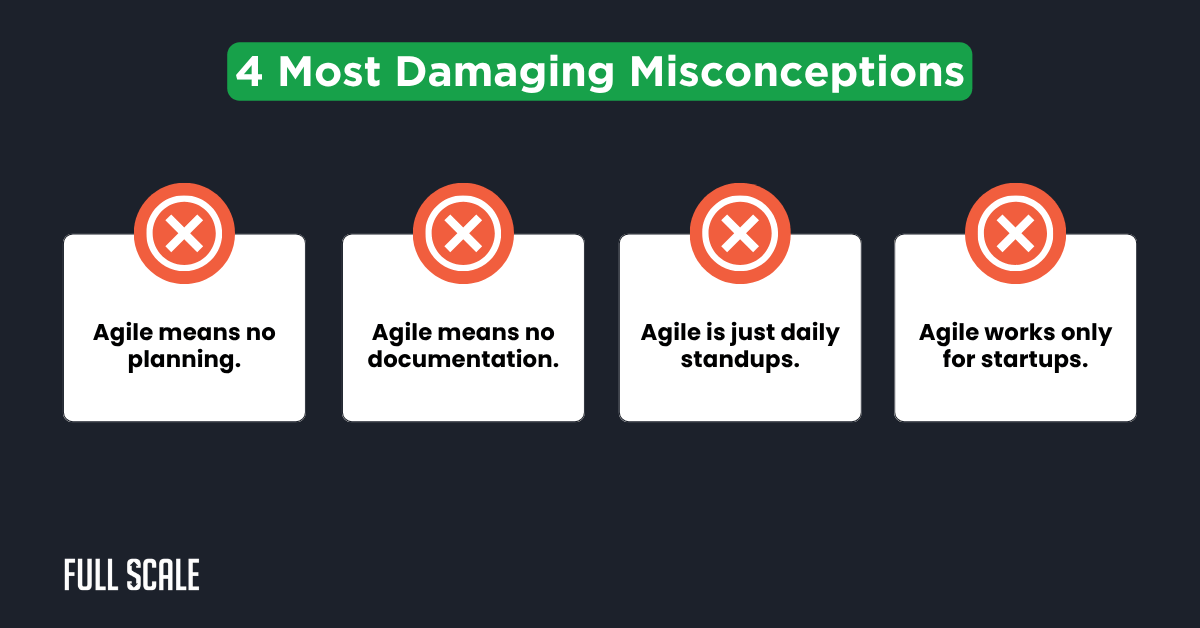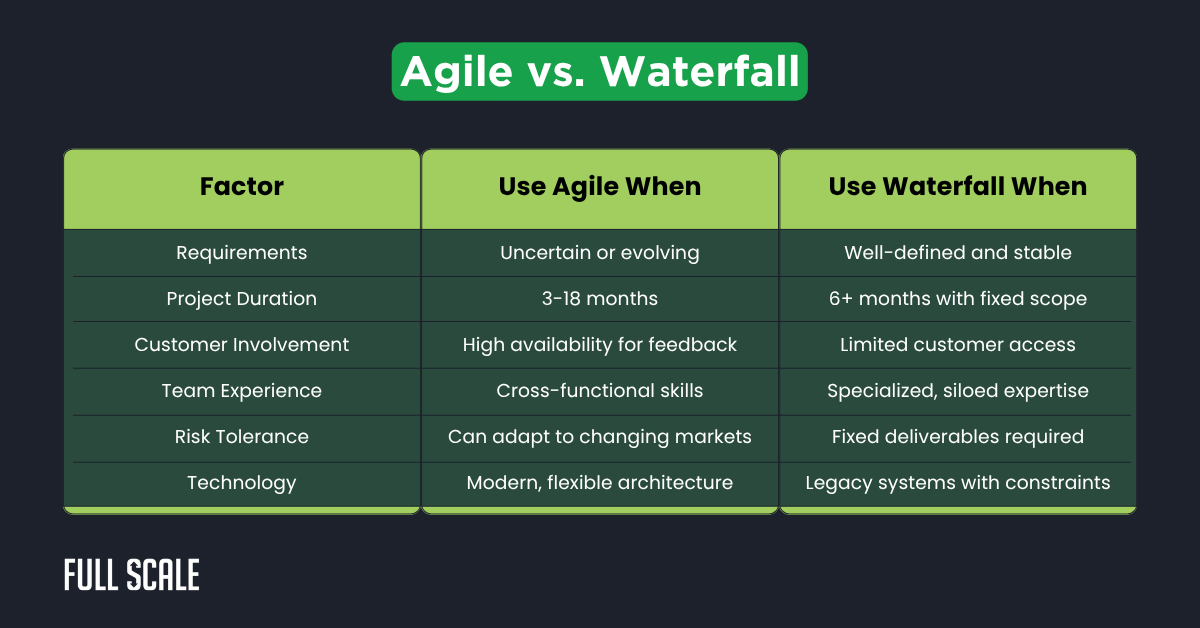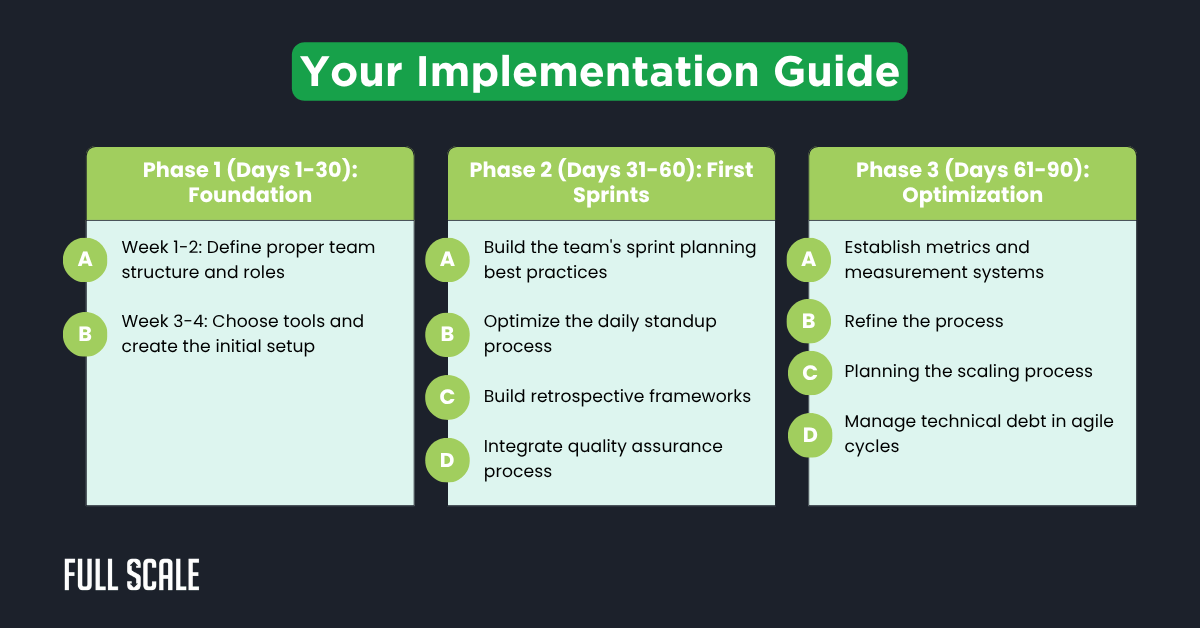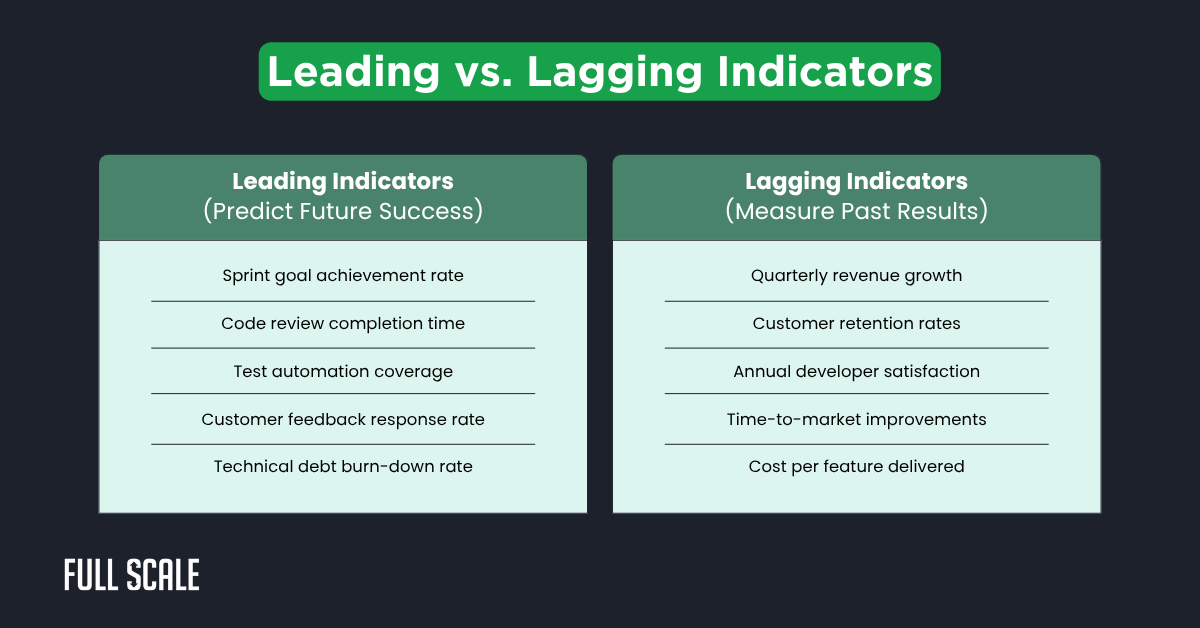Last Updated on 2025-06-29
83% of companies claim to use Agile, yet only 23% see the promised benefits. Here’s why most Agile implementations fail—and how to get it right.
As CTOs and technical leaders, we’ve witnessed countless “Agile transformations” that were anything but agile.
We’ve seen the same pattern repeat across industries: organizations adopt the ceremonies, tools, and terminology of Agile while missing its fundamental purpose.
The result? Waterfall projects disguised as sprints, burned-out teams, and executives wondering why their expensive transformation delivered so little value.
What Is Agile Software Development Really?
Agile is a collaborative approach to software development that prioritizes working software, customer feedback, and adaptive planning over rigid processes and extensive documentation. It’s not about moving fast and breaking things—it’s about moving smart and building the right things.
This guide cuts through the hype to show technical leaders how Agile actually works in practice, when it delivers results, and how to implement it successfully across distributed teams. Whether you’re a CTO scaling engineering teams, a product leader fighting feature backlogs, or a CFO questioning development ROI, you’ll find practical frameworks that address your specific challenges.
Agile Reality Check: What Are the Real Benefits of Agile Methodology?
Agile methodology delivers these core benefits: faster response to market changes, improved product quality through iterative feedback, reduced project risk through early value delivery, and increased team productivity through collaborative decision-making.
The Agile Manifesto, written by 17 software practitioners in 2001, established four fundamental values that remain relevant today:
- Individuals and interactions over processes and tools
- Working software over comprehensive documentation
- Customer collaboration over contract negotiation
- Responding to change over following a plan
In practical terms, this means prioritizing human communication, delivering functional software frequently, involving customers in the development process, and maintaining flexibility to adapt when requirements change.
These aren’t theoretical ideals—they’re operational principles that guide daily decisions in successful Agile teams.
According to the 2024 State of Agile Report, the measurable outcomes include 37% faster time to market, 16% improvement in productivity, 20% increase in revenue growth, and 14% improvement in team satisfaction.
4 Common Misconceptions Debunked
Agile is the overarching methodology philosophy with four core values and twelve principles. At the same time, Scrum is a specific framework that implements Agile through defined roles, events, and artifacts like sprints and daily standups.
Let us address the most damaging misconceptions we’ve encountered:

- “Agile means no planning.” → This is entirely false. Agile involves extensive planning at multiple levels: release planning, sprint planning, and daily planning. The difference is that plans are treated as living documents rather than contracts set in stone. Teams plan continuously and adapt based on new information.
- “Agile means no documentation.” → Another myth. Agile teams produce documentation that adds value—user stories, technical specifications, API documentation, and deployment guides. They avoid documentation that becomes outdated quickly or serves no practical purpose.
- “Agile is just daily standups.” → This reduces Agile to its most visible ceremony while ignoring the cultural and process changes that make it effective. Standups are communication tools, not the methodology itself.
- “Agile works only for startups.” → Enterprise organizations like Spotify, ING Bank, and Microsoft have successfully scaled Agile across thousands of developers. The key is adapting the practices to the organizational context while preserving core principles.
When Agile Actually Works vs. When It Doesn’t
Understanding when Agile delivers value versus when it creates chaos is crucial for technical leaders making implementation decisions.
Agile vs. Waterfall: When to Use Each

Ideal conditions for Agile success:
- Leadership commitment to cultural change, not just process adoption
- Cross-functional teams with direct customer access
- Product roadmap flexibility based on market feedback
- Technical architecture that supports iterative delivery
- An organization willing to experiment and learn from failures
Red flags indicating poor Agile fit:
- Highly regulated industries with extensive approval processes
- Projects with fixed scope, budget, and timeline constraints
- Teams without decision-making authority
- Organizations resistant to transparent communication
- Technical debt is so extensive that any change breaks existing functionality
The Technical Leader’s Agile Implementation Framework
Successful Agile transformation requires more than adopting ceremonies—it demands systematic preparation, phased implementation, and continuous optimization.
This framework provides technical leaders with a proven roadmap for implementing Agile practices that actually deliver business value.
Pre-Implementation Assessment
Technical leaders need to evaluate organizational readiness before implementing sprints and standups. This assessment prevents the common mistake of implementing Agile practices without the supporting infrastructure.
Technical Architecture Readiness Checklist
- Continuous Integration/Deployment Pipeline: Can you safely deploy code changes multiple times per day?
- Automated Testing Coverage: Do you have sufficient unit, integration, and end-to-end tests?
- Modular Architecture: Can teams work independently without breaking each other’s code?
- Monitoring and Observability: Can you detect and resolve issues quickly in production?
- Infrastructure as Code: Can you provision and scale environments programmatically?
Team Skill Gap Analysis
- Cross-functional capabilities within teams
- Communication skills for distributed collaboration
- Technical skills for modern development practices
- Product knowledge and customer empathy
- Facilitation and conflict resolution abilities
Legacy System Integration Planning
- API strategy for connecting new and old systems
- Data migration and synchronization approaches
- Gradual replacement versus big-bang transitions
- Risk mitigation for critical business functions
90-Day Implementation Roadmap
Agile implementation typically takes 90 days for initial setup and 6-12 months for full organizational adoption. Success depends on team size, existing processes, and leadership commitment to cultural change.
This timeline provides a realistic framework for organizations transitioning from traditional development approaches.

Phase 1 (Days 1-30): Foundation
Week 1-2: Team Structure and Roles
- Define cross-functional team composition (5-9 people optimal)
- Establish Product Owner and Scrum Master responsibilities
- Clarify decision-making authority and escalation paths
- Create team working agreements and communication protocols
Week 3-4: Tool Selection and Initial Setup
- Choose collaboration tools (Jira, Azure DevOps, or Linear)
- Set up version control workflows and branching strategies
- Configure continuous integration pipelines
- Establish team communication channels (Slack, Microsoft Teams)
Phase 2 (Days 31-60): First Sprints
Sprint Planning Best Practices
- Start with 2-week sprints for a predictable rhythm
- Limit work in progress to maintain quality
- Include technical debt reduction in every sprint
- Plan for a 20% capacity buffer to handle unplanned work
Daily Standup Optimization
- Focus on blockers and collaboration opportunities
- Keep discussions under 15 minutes
- Use asynchronous updates for distributed teams
- Address detailed discussions in separate meetings
Retrospective Frameworks That Work
- What went well / What didn’t go well / What to try next
- Start / Stop / Continue format
- Timeline analysis for significant events
- Action items with owners and deadlines
Quality Assurance Integration
- Shift testing left with developer-written tests
- Include QA in story refinement and acceptance criteria
- Automate regression testing for faster feedback
- Implement the definition of done that includes quality gates
Phase 3 (Days 61-90): Optimization
Metrics and Measurement Systems
- Track team velocity trends, not absolute velocity
- Measure cycle time from commit to production
- Monitor technical debt through code quality metrics
- Assess customer satisfaction with delivered features
Process Refinement
- Adjust the sprint length based on team feedback
- Optimize ceremonies for efficiency and value
- Refine estimation techniques and story sizing
- Improve cross-team coordination mechanisms
Scaling Considerations
- Establish communities of practice across teams
- Coordinate dependencies through PI planning or similar events
- Align team roadmaps with business objectives
- Share learnings and best practices organization-wide
Managing Technical Debt in Agile Cycles
Technical debt is inevitable in fast-moving Agile environments. The key is making it visible and addressing it systematically:
- Reserve 20% of sprint capacity for technical debt reduction
- Track debt accumulation through code complexity metrics
- Prioritize debt that impacts team velocity or system reliability
- Communicate technical debt impact in business terms to stakeholders
Real-World Implementation Guide by Stakeholder
As engineering leaders, the primary concerns center on maintaining technical excellence while scaling teams and accelerating delivery. Here’s how Agile addresses these specific challenges:
Technical Challenges Solved
Code Quality Maintenance in Fast Iterations
The biggest fear we hear from CTOs is that Agile sacrifices quality for speed. In reality, effective Agile practices improve code quality through:
- Test-driven development practices that ensure functionality works as designed
- Pair programming and code reviews that distribute knowledge and catch defects early
- Continuous refactoring that prevents technical debt accumulation
- Definition of done that includes quality gates before code reaches production
Architecture Decision-Making in Agile Teams
Agile doesn’t mean abandoning architectural planning—it means making architecture decisions at the right time with the right information:
- Establish architectural principles that guide team decisions
- Create lightweight decision records that capture context and rationale
- Review architectural decisions during sprint retrospectives
- Evolve architecture incrementally based on actual usage patterns
Managing Technical Debt During Sprints
Technical debt in Agile requires a balanced approach:
- Make debt visible through tracking and measurement
- Allocate 20% of sprint capacity specifically for debt reduction
- Prioritize debt that impacts team velocity or customer experience
- Communicate debt impact in business terms to secure stakeholder buy-in
Remote Team Coordination Best Practices
Distributed Agile teams require intentional coordination strategies:
- Overlap working hours for real-time collaboration (minimum 4 hours)
- Use asynchronous communication for documentation and updates
- Implement mob programming sessions for knowledge transfer
- Establish clear handoff protocols between time zones
Case Study: FinTech Scaling Success
A 200-person FinTech company successfully scaled Agile across eight distributed teams by implementing several key strategies:
Challenge: Coordinating development across San Francisco, Austin, Guadalajara, and Philippine teams while maintaining regulatory compliance and system stability.
Solution
- Established architectural guild with representatives from each team
- Implemented 3-week sprints to accommodate regulatory review cycles
- Created a shared component library to reduce duplication and improve consistency
- Used feature flags to deploy code without exposing functionality until compliance approval
Results
- 40% reduction in time-to-market for new features
- 60% decrease in production defects through improved testing practices
- 25% improvement in developer satisfaction scores
- Zero regulatory compliance violations during 18-month transformation
Key Lessons
- Longer sprints may be necessary in regulated environments
- Architectural consistency becomes critical at scale
- Feature flags enable Agile practices in compliance-heavy contexts
- Cross-team collaboration requires explicit investment and support
Common Failure Patterns and Solutions
Why do 77% of Agile implementations fail? Why do agile projects fail in large companies?
Agile projects fail in large companies due to a lack of cultural change (45%), poor leadership buy-in (32%), inadequate training (28%), and treating Agile as a process rather than a mindset shift.
After analyzing hundreds of Agile implementations, these failure patterns emerge consistently.
Lack of Cultural Change (45% of Failures)
Organizations adopt Agile ceremonies without changing decision-making processes, communication patterns, or success metrics. Teams hold daily standups but still wait weeks for approvals. They plan sprints but can’t deploy code without lengthy review cycles.
Solution: Cultural change requires intentional effort:
- Leadership must model Agile behaviors and decision-making
- Remove organizational barriers to team autonomy
- Align compensation and promotion criteria with Agile values
- Celebrate learning from failures, not just avoiding them
Poor Leadership Buy-in (32% of Failures)
Middle management often resists Agile because it threatens traditional command-and-control structures. They demand predictable timelines while expecting teams to adapt to changing requirements.
Solution: Address leadership concerns directly:
- Train managers in servant leadership and coaching skills
- Show how Agile improves predictability through frequent delivery
- Provide metrics that demonstrate business value, not just team productivity
- Create new career paths for managers in Agile organizations
Troubleshooting Guide
“We’re doing waterfall in 2-week cycles.”
Symptoms: Teams plan entire features in detail upfront, work in isolation for two weeks, then demo completed work. No customer feedback influences development. Requirements don’t change during sprints.
Solution Steps:
- Break features into smaller, user-valuable increments
- Involve customers in sprint planning and review
- Focus on working software that solves real problems
- Encourage experimentation and learning during sprints
- Measure success by customer satisfaction, not task completion
“Agile ceremonies waste time.”
Symptoms: Meetings feel ritualistic rather than valuable. Team members multitask during ceremonies. Discussions don’t lead to decisions or improvements.
Optimization Techniques:
- Daily Standups: Focus on coordination, not status reporting
- Sprint Planning: Prepare thoroughly and maintain focus
- Sprint Reviews: Make demos interactive and customer-focused
- Retrospectives: Generate actionable improvements
Here’s How You Measure Real Agile Success
How to measure agile development success? Measure Agile success through 5 key metrics.
- Business Value Delivered: Revenue attributable to new features, cost savings from process improvements
- Customer Satisfaction Improvements: Net Promoter Score trends, support ticket reduction
- Team Satisfaction and Retention: Developer happiness scores, team retention rates
- Technical Debt Trends: Code complexity metrics, deployment reliability
- Time to Market Improvements: Lead time from idea to production, release frequency
Dashboard Templates and KPIs
Leading vs. Lagging Indicators

Agile with Distributed and Offshore Teams
Working with distributed teams introduces complexity that requires intentional practices and cultural adaptation. The key is maintaining Agile principles while accommodating geographic and cultural differences.
Time Zone Coordination Strategies
- Establish Core Overlap Hours: Identify a minimum 4-hour overlap for real-time collaboration
- Implement Follow-the-Sun Development: Structure work to pass naturally between time zones
- Adapt Ceremony Timing and Format: Rotate meeting times to share inconvenience fairly
Communication Tool Optimization
- Video conferencing for complex discussions
- Instant messaging for quick questions
- Asynchronous documentation for knowledge sharing
- Project management tools with notifications
Making Distributed Daily Standups Actually Useful
Before the Meeting
- Team members post async updates in shared channel
- Include blockers, progress, and specific help needed
- Review others’ updates to prepare for meaningful discussion
During the Meeting (15 minutes maximum)
- Focus on coordination and collaboration opportunities
- Address blockers immediately or schedule a follow-up
- Make decisions that require full team input
The Future of Agile
As technology evolves and work patterns shift, Agile practices must adapt to remain effective in modern development environments.
AI integration, hybrid methodologies, and distributed collaboration reshape how teams implement Agile principles while maintaining their core values.
AI Integration in Agile Processes
- Automated sprint planning and capacity prediction
- Intelligent code review and testing suggestions
- Predictive analytics for team health monitoring
- Customer feedback analysis and prioritization
- Automated test case generation
Hybrid Methodologies
- SAFe (Scaled Agile Framework) for enterprise coordination
- Design Thinking + Agile for human-centered development
- Lean Startup + Agile for hypothesis-driven development
- DevOps + Agile for continuous delivery
Preparing for Evolution
Technical Skills
- Cloud-native development and microservices
- Data engineering and AI integration
- Security-first development practices
- Platform engineering capabilities
Collaboration Skills
- Cross-functional communication
- Remote leadership and facilitation
- Customer empathy and user research
- Systems thinking and architecture
Getting Expert Help
When to Consider Agile Software Development Consulting
- Previous Agile attempts failed to deliver expected results
- Teams struggling with basic practices after initial training
- Organizational resistance prevents effective implementation
- The technical infrastructure is inadequate for iterative delivery
- Rapid growth requires scalable development practices
Evaluation Criteria for Agile Consultants
- Minimum 5 years of hands-on implementation experience
- Experience with similar organizations and industries
- Technical background in modern development practices
- Track record of sustainable transformation
- Knowledge transfer focuses to build internal capability
Working with Offshore Development Partners
Choose partners who understand both Agile principles and distributed collaboration:
- Demonstrated Agile experience in distributed environments
- Strong communication skills and cultural compatibility
- Adequate timezone overlap for real-time collaboration
- Modern technical infrastructure and development practices
- Client references for successful long-term partnerships
Ready to Scale Your Development Teams with Proven Agile Practices?
Implementing Agile successfully while scaling distributed teams requires more than internal expertise—it demands partners who understand both the methodology and the challenges of managing global development resources.
Our Agile-First Approach Delivers Results
- 90-Day Integration Guarantee—Seamless onboarding with your existing Agile processes
- Timezone-Optimized Collaboration—4-6 hour overlap for real-time sprint ceremonies
- Proven Team Scaling—From single developers to full cross-functional squads
- Enterprise-Grade Quality—CI/CD, automated testing, and technical debt management built in
- Transparent Communication—Daily standups, sprint reviews, and retrospectives as standard practice
Start Your Agile Transformation Today
Whether implementing Agile for the first time or scaling existing practices across distributed teams, Full Scale provides the expertise, resources, and cultural alignment needed for sustainable success.
Get Started in 3 Simple Steps
- Free Consultation—Assess your current Agile maturity and scaling needs
- Team Matching—Connect with pre-vetted developers experienced in your tech stack and industry
- Rapid Integration—Begin collaborating within 2 weeks with full sprint participation
Explore Our Agile Software Development Services
Frequently Asked Questions
How long does agile implementation take?
Complete Agile implementation takes 6-12 months, with initial setup requiring 90 days. The timeline depends on organization size, existing processes, and cultural readiness for change.
What’s the difference between Agile and Scrum?
Agile is a methodology philosophy with four core values, while Scrum is a specific framework that implements Agile principles through sprints, roles (Scrum Master, Product Owner), and ceremonies.
How much does agile implementation cost?
- Small Teams (5-20 developers): $25K-$75K initial, $50K-$150K annual
- Medium Organizations (50-200 developers): $100K-$300K initial, $200K-$500K annual
- Large Enterprises (200+ developers): $500K-$2M initial, $1M-$5M annual
What are the main benefits of agile development?
- 37% faster time-to-market
- 16% improvement in productivity
- 20% increase in revenue growth
- 50% reduction in project failure rates
When should companies avoid agile?
- Extensive regulatory documentation is required before development
- Fixed scope, budget, and timeline with no flexibility
- Well-understood requirements with minimal expected change
- Legacy systems that can’t support iterative delivery
What are common agile development mistakes?
- Implementing ceremonies without understanding principles
- No definition of done, allowing incomplete work
- Poor Product Owner with limited customer knowledge
- Technical debt accumulation without systematic reduction
- Individual hero culture instead of team collaboration

Matt Watson is a serial tech entrepreneur who has started four companies and had a nine-figure exit. He was the founder and CTO of VinSolutions, the #1 CRM software used in today’s automotive industry. He has over twenty years of experience working as a tech CTO and building cutting-edge SaaS solutions.
As the CEO of Full Scale, he has helped over 100 tech companies build their software services and development teams. Full Scale specializes in helping tech companies grow by augmenting their in-house teams with software development talent from the Philippines.
Matt hosts Startup Hustle, a top podcast about entrepreneurship with over 6 million downloads. He has a wealth of knowledge about startups and business from his personal experience and from interviewing hundreds of other entrepreneurs.




